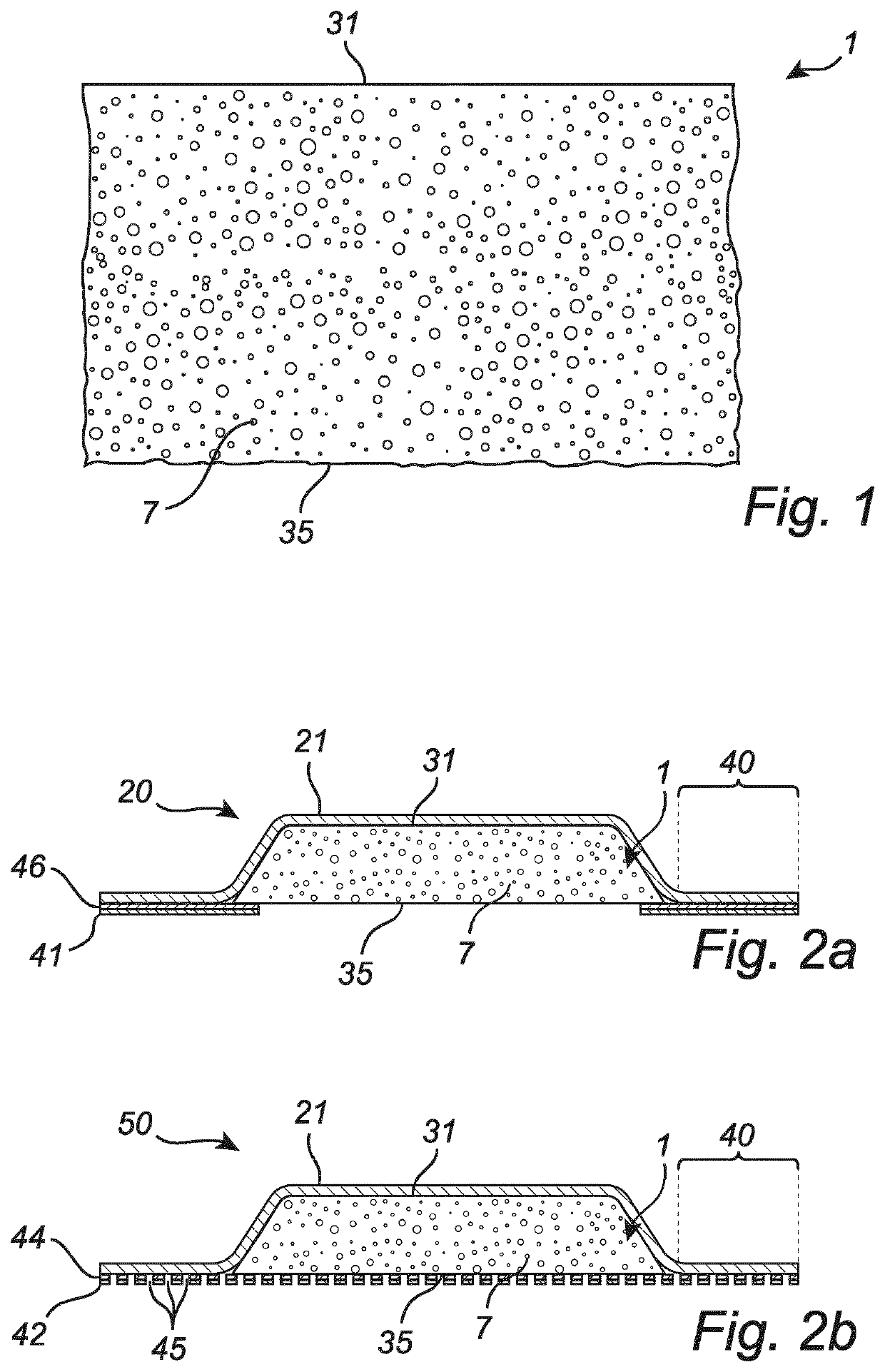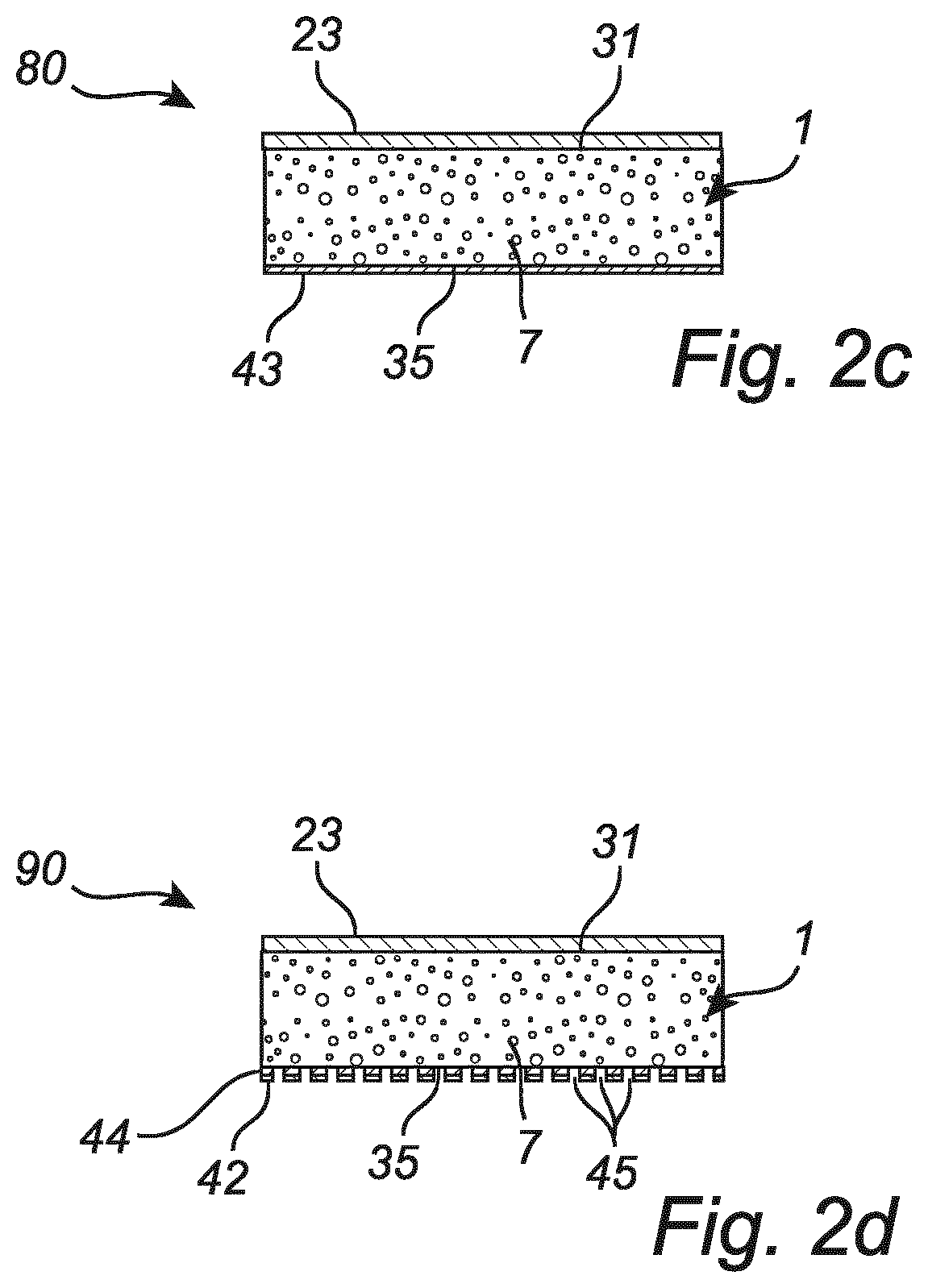Foam in wound treatment
- Summary
- Abstract
- Description
- Claims
- Application Information
AI Technical Summary
Benefits of technology
Problems solved by technology
Method used
Image
Examples
example 1
Method of Preparing a Hydrophilic Polyurethane Foam
[0091]A foam layer was prepared using the following steps (1)-(3): (1) An aqueous mixture comprising surfactant Pluronic® L62 0.125% w / w was prepared; (2) the aqueous mixture was mixed with the prepolymer Trepol® B1, at a 1.6:1 ratio by weight (aqueous mix. / prepolymer) to give an emulsion mixture; (3) the emulsion mixture was poured onto and spread out on a casting paper (20×30 cm) and was allowed to cure at standard condition (at room temperature) to give a foam with a thickness of about 3 mm (foam thickness is controlled by adapting the thickness of spread of the emulsion mixture in step (3)). Chemicals used are commercially available and are, in particular: Trepol® B1 (TDI based prepolymer) from Rynel Inc., and Pluronic® L62, commercially available from BASF.
example 2
Method of Preparing a Hydrophilic Polyurethane Foam with Added Nucleating Particles
[0092]A foam layer was prepared using the following steps (1)-(3): (1) An aqueous mixture comprising surfactant Pluronic® L62 0.125% w / w and alumina trihydrate 7% w / w (SB-432 commercially available from Akrochem Corporation; 7% w / w of aqueous mix. corresponds to ca. 10% w / w of the final dried foam product, given prepolymer mixture ratio in step (2)) was prepared; (2) the aqueous mixture was mixed with the prepolymer Trepol® B1 at 1.6:1 ratio by weight (Aqueous mix. / prepolymer) to give an emulsion mixture; (3) the emulsion mixture was poured onto and spread out on a casting paper (20×30 cm) and was allowed to cure at standard condition (at room temperature) to give a foam having a thickness of about 3 mm (foam thickness is controlled by adapting the thickness of spread of the emulsion mixture in step (3)).
example 3
Foam Pore Cell Size Analysis
[0093]Images of cross-sections of the foam layers produced in Example 1 and Example 2 were analyzed according ISO 13322-1 using an Olympus SZX16 microscope and Olympus Stream Image Analysis Software Version 510 (software is based on ISO 13322-1) from Olympus Soft Imaging Solution GmbH, Johann-Krane-Weg 39, D48149 Munster, Germany. FIG. 3 and FIG. 4 are histograms of cell size analysis of the foam material according to Example 1 (without nucleating particles) and Example 2 (with ca. 10% nucleating particles (alumina trihydrate) by weight of the foam material), respectively.
[0094]As can be seen in FIG. 4, 87.6% of all foam cells of the hydrophilic polyurethane foam prepared according to Example 2, which foam includes nucleating particles according to an embodiment of the invention, have an average cell size in class 1 (corresponding to 0.01 mm2 or less). In contrast, as can be seen in FIG. 3, 69.6% of all foam cells in the corresponding foam material withou...
PUM
| Property | Measurement | Unit |
|---|---|---|
| Fraction | aaaaa | aaaaa |
| Percent by mass | aaaaa | aaaaa |
| Percent by mass | aaaaa | aaaaa |
Abstract
Description
Claims
Application Information
 Login to View More
Login to View More - R&D
- Intellectual Property
- Life Sciences
- Materials
- Tech Scout
- Unparalleled Data Quality
- Higher Quality Content
- 60% Fewer Hallucinations
Browse by: Latest US Patents, China's latest patents, Technical Efficacy Thesaurus, Application Domain, Technology Topic, Popular Technical Reports.
© 2025 PatSnap. All rights reserved.Legal|Privacy policy|Modern Slavery Act Transparency Statement|Sitemap|About US| Contact US: help@patsnap.com



